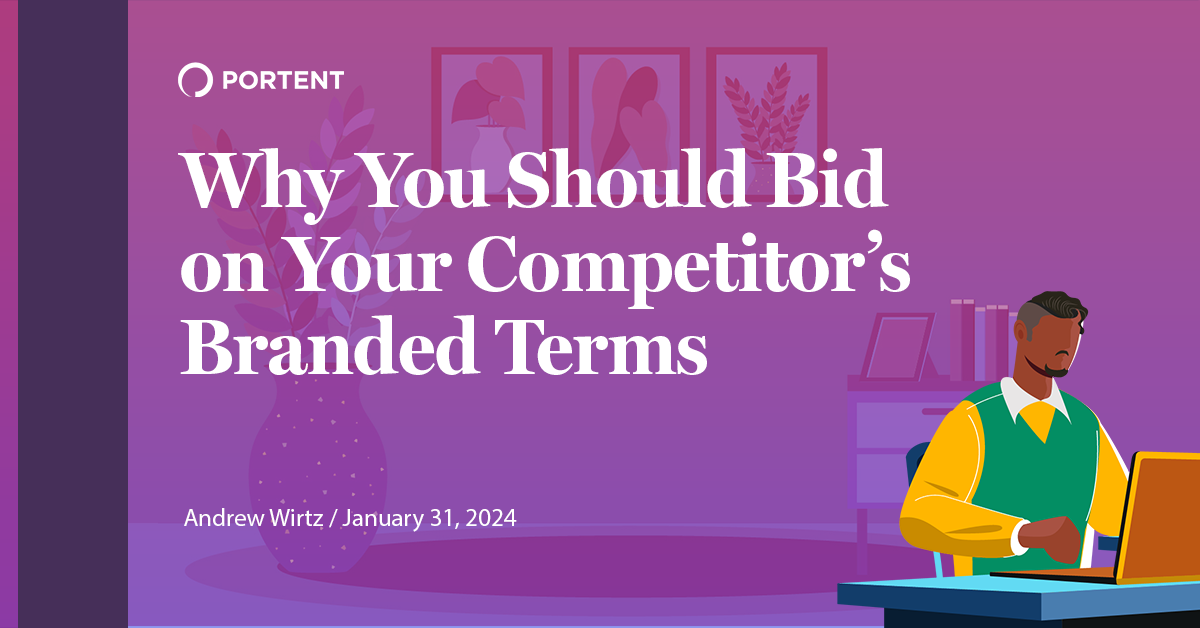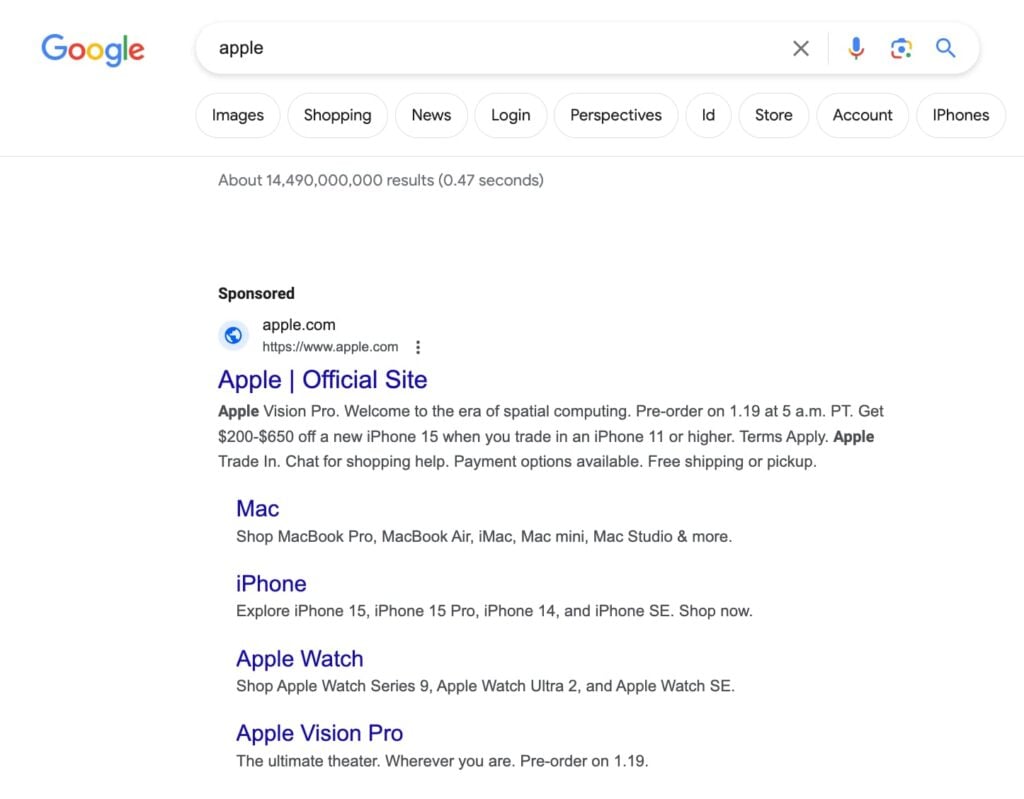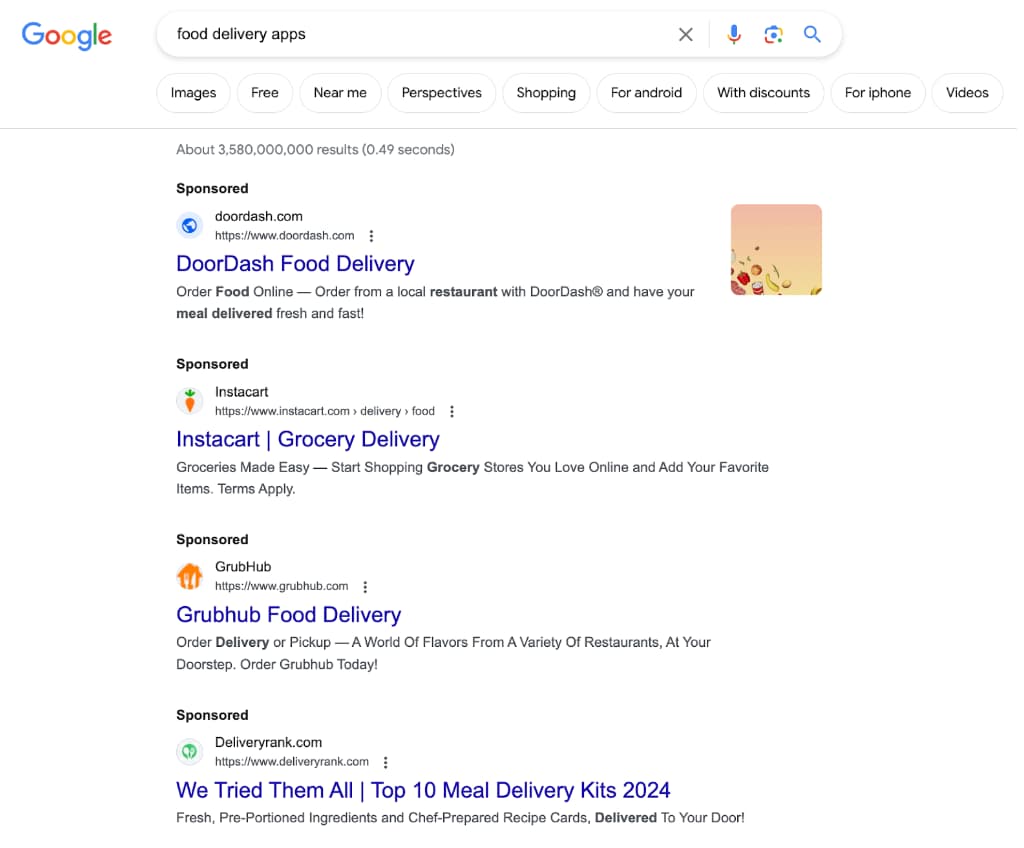
The topic of branded bidding leads many marketers to the question: “If I bid on my own branded terms, should I also bid on my competitor’s branded terms?”
There are many benefits to bidding on competitor brand terms, including lower cost per click, less competition, and capturing your competitor’s customers!
In this post, we will argue why bidding on competitors’ brand terms is part of a successful middle-funnel PPC campaign and should be considered within all verticals.
What is Brand Bidding?

Branded bidding is a PPC strategy when you bid on your brand terms or brand names of other competitors. Some believe bidding on your brand terms is not worth the investment, as these keywords can rank organically. While brand terms may rank higher organically, it is worth investing in your brand terms, and we have the data to prove it. If you are not bidding on your brand terms, competitors will!
The example above shows how Apple has bid on its brand terms. In this example, while Apple.com likely has enough domain authority to appear in the first organic position regardless, like many brands, they opt to bid on their brand terms to guarantee that they maintain the first position in the search results page (SERP).
Branded bidding is a worthwhile investment if you are in a highly competitive market and know your competitors are probably bidding on your brand terms—which segues us into why you should be bidding on your competitor’s branded keywords.
Benefits of Bidding on Your Competitors’ Brand Terms

Many brands target their competitors’ keywords for various reasons. The example above shows that DoorDash targets “uber eats,” one of its key competitors in the food delivery industry.
Below, we will use the UberEats/DoorDash example to explain the main benefits of allocating some of your PPC budget to bidding on your competitor’s brand terms.
Build Brand Awareness
The hypothetical customer searching for “Uber Eats” may have had no previous experience with DoorDash. Regardless, if they click on the sponsored DoorDash result, they are now exposed to their brand name and may grow to associate it with food delivery.
Gain New Customers
The UberEats customer may click on DoorDash’s sponsored ad and convert. While the conversion rate is usually lower when bidding on competitors’ brand keywords, the cost per click (CPC) on brand terms is generally lower than on non-branded keywords. The lifetime value of a new customer will likely be worth the higher initial cost to convert them.
Dominate the SERP
Like building brand awareness, the more space you can capture on a competitor’s branded term SERP, the more likely users will consider your brand and potentially do further research. For example, suppose you have a paid ad targeting their brand name and a comparative landing page for Doordash vs. UberEats that ranks organically. In that case, you can reap the benefits of having two positions on the SERP, resulting in increased clicks and impressions.
Reduce Your Competition
If you search for the non-branded terms in the food delivery space, you have four ads at the top of the SERP. The average CPC for “food delivery apps” in January 2024 is $3.79.
The branded search for “uber eats” will cost an average of only $1.80, less than half the price of the non-branded term! Low prices and fewer paid ads on branded searches can decrease the cost per conversion.

Capture High-Intent Audiences
When building audiences for your top-of-funnel campaigns, competitor terms can bring in new users who have yet to visit your site.
If users click on your competitor’s term ad but do not convert, you can remarket to them in the future and know they are qualified visitors.
Along with remarketing lists, you can use Google’s proprietary audience tools. For example, DoorDash could create a custom intent audience targeting all users who have searched for terms related to “uber eats” in the past 90 days.
Google’s internal audiences, such as “custom intent,” “in-market,” and “infinity,” are generally going to see lower conversion rates than a remarketing audience.
Potential Risks and Challenges to Consider
When bidding on competitor brand keywords, there are some potential challenges and risks to consider.
Trademark Infringement
As there have been legal repercussions for brands bidding on competitor brand terms in the past, there are valid reasons why some marketers and companies are apprehensive to do this strategy. With clear guidelines on executing this within trademark laws, there are ways to work around the challenges of brand bidding.
When making ads targeting your competitor’s brand names, you have to be careful not to include their name in the headlines or descriptions of your ads. If the advertiser finds and reports these on the Google SERP, you risk Google pausing your campaign or your competitor taking legal action.
Bidding Retaliation
When targeting your competitor’s brand names, you risk upsetting competitors and inspiring them to start targeting your brand name in retaliation. This unnecessary competition can increase your CPC on brand terms and risk decreasing the search impression share on your own brand keywords.
While this is not avoidable, you can reduce the risk by only targeting competitors who target your brand terms.

You may see some of your competitors when looking at your branded campaign’s auction insights in Google Ads (as shown in the screenshot above). Another way to check if competitors bid on your brand name is to simply search your brand terms in Google and see if competitor ads appear.
High Costs per Conversion
As mentioned under the “Trademark Infringement” challenge, you cannot include the competitor brand name keywords you are targeting in your ad copy. Because of this, you will inevitably see lower quality scores on competitor keywords.
This means you will also have lower search impression share, top impression share, and click-through rates. All these factors, combined with visitors who click on your ad expecting to see your competitors’ websites, will result in low conversion rates and high conversion costs.
If you have a limited PPC budget or are struggling with campaign performance, there may be better investments than competitor brand bidding until you can scale your budget.
Tips to Successfully Bid on Competitors’ Keywords
Several ways to improve the success of targeting competitor keywords include frequently updating ads, creating comparative landing pages, and following legal requirements.
Emphasize Value Proposition in Ad Copy
As mentioned above, you can’t include competitor’s brand names in your ads. So, to entice visitors to your site, emphasize what sets your brand apart from the competitors. Understanding the weaknesses of particular competitors should inform which value propositions to pin in your headlines as “position one” or focus on across all headlines and descriptions.
Create Comparative Landing Pages
If you only send visitors to your homepage or product page, they may think they clicked on the wrong link and return to Google to look for the competitor’s site.
Proactively create landing pages to direct paid traffic that compares your brand vs. your competitor and moves more visitors into the consideration phase of the funnel.
See this example of a comparative landing from Wix on Wix vs WordPress.
Catching their attention by including the brand name they searched for within the landing page will increase their engagement and time on-site.
Follow Legal Recommendations
To avoid copyright infringement, consult your legal team before creating competitor ads. Ensuring that your landing page content is accurate and ads follow legal guidelines can save your brand from needing to take future legal action.
Constantly Test and Optimize Keywords
Once you have created your campaigns, regularly check the keywords in your competitor campaign. See which keywords are limited by low-quality scores and consider adding them to your paid landing page to improve user experience! If you find competitor-branded terms have a very low search volume, consider pausing low-performing terms and testing new keywords. Also, check your search term report and add negative keywords to improve quality scores.
Moving Forward with Competitive Keyword Bidding
Bidding on competitors’ brand terms is a recommended middle-funnel PPC campaign strategy to target the ‘consideration’ part of your customer’s journey. Before creating the campaigns:
- Check with your legal department.
- Analyze each competitor’s value propositions and weaknesses.
- Evaluate what landing pages you have on your site or will need to create before launching.
Continue testing new keywords and checking quality scores to generate the highest return on investment. Despite the drawbacks, the potential lifetime value of customers gained from your competitor bidding makes this a worthwhile investment and strategy!

![YMYL Websites: SEO & EEAT Tips [Lumar Podcast] YMYL Websites: SEO & EEAT Tips [Lumar Podcast]](https://www.lumar.io/wp-content/uploads/2024/11/thumb-Lumar-HFD-Podcast-Episode-6-YMYL-Websites-SEO-EEAT-blue-1024x503.png)

